Compulab Rolls-Out Passively-Cooled Airtop Systems
by Anton Shilov on January 14, 2016 5:05 AM EST
Compulab, a maker of miniature and small form-factor computers, is introducing its first desktop system called Airtop today. The new computer can be equipped with rather high-performance components, but is completely fanless and only uses the company’s proprietary natural air-flow (NAF) cooling technology.
Compulab’s Airtop is a compact 7.5-liter desktop system that can dissipate up to 200W of heat using only passive cooling methods. The Airtop utilizes various industry-standard components and can be configured as a gaming PC, a server or a workstation. The system is based on a proprietary motherboard featuring Intel’s C226 platform controller hub (PCH) designed specifically for the Airtop with NAF cooling. The mainboard places CPU socket, DIMM slots, PCI Express x16 slot and other components in a way to enable the most efficient dissipation of heat. To eliminate hot components from the case, the Airtop uses an external PSU with a mini-DIN connector.
The proprietary Airtop mainboard is compatible with Intel Core i7 and Intel Xeon E3 v4 microprocessors based on Intel’s Haswell or Broadwell micro-architectures (LGA1150 packaging) as well as various graphics cards, including NVIDIA’s GeForce GTX 950 and Quadro M4000.
The Airtop can be equipped with up to 32 GB of DDR3-1866 memory, four 2.5-inch Serial ATA HDDs/SSDs, one M.2 solid-state drive and one mSATA solid-state drive. The system features two Gigabit Ethernet network controllers (four more may be added using an extension card), a 802.11ac Wi-Fi card with two SIM card sockets, four SMA antennas, four USB 3.0 ports on rear panel, six USB 2.0 ports in total, three RS232 ports, multi-channel audio and so on. While the system utilizes its own mainboard, all the other components are industry-standard and can be upgraded when and if needed.
The NAF heat-exchange system uses two special side-panels, each of which can dissipate up to 100W of heat. The side-panels are equipped with traditional flat copper heat-pipe arrays (with micro-channels) that take away heat from the hottest components (i.e., the CPU and the GPU) and spread it across the side-panel. The heat from the heat-pipe arrays is removed by the special air-tube panels consisting of 14 tubes with air inside. Once the air gets hot, it starts to rise up, removing heat from the side panels (see Compulab's video for details). Everything happens naturally (via convection) and completely silently. The air tubes are open on both ends and efficiency of convection depends on the movement of air through them. For efficient cooling, owners of Compulab’s Airtop will have to ensure that the tubes are not clogged with dust, which is common in industrial and other environments.
While Compulab’s Airtop is in many ways unique, it reminds us of Zalman’s TNN 500 and TNN 300 fanless cases released about a decade ago. Those cases were considerably bigger and acted like giant heatsinks with a lot of heat-pipes inside, but they combined the same cooling techniques as the Airtop.
Compulab claims that it took years to develop the NAF heat-exchange technology and three years to design the Airtop system. Right now, the desktop is only compatible with previous-generation Intel microprocessors and does not support modern technologies like NVMe or USB 3.1, but eventually the company could develop a more advanced motherboard for the latest-generation Skylake and the upcoming Kaby Lake chips in LGA1151 packaging.
The Airtop is relatively small, its dimensions are 10 cm (w) x 30 cm (h) x 25.5 cm (d) – 4” (w) x 12” (h) x 10” (d). The weight of the PC depends on configuration and can be between 4 and 7 kilograms.
The Compulab Airtop is available as a pre-configured system or as a barebone SFF PC for DIY enthusiasts. Since the system is unique and uses numerous components designed specifically for the Airtop, it naturally is not affordable. The Airtop barebone costs $1128, the Airtop-S passively-cooled server (featuring the Intel Xeon E3-1285L v4 CPU) starts at $1810, the Airtop-G gaming PC (with the Intel Core i7-5775C and the NVIDIA GeForce GTX 950 graphics card) is priced at $1968, whereas the Airtop-W workstation (with Intel’s Xeon E3-1285L v4 chip and NVIDIA’s Quadro M4000 graphics adapter) costs $2999. The systems will be available in Q1 2016.
Source: Airtop PC


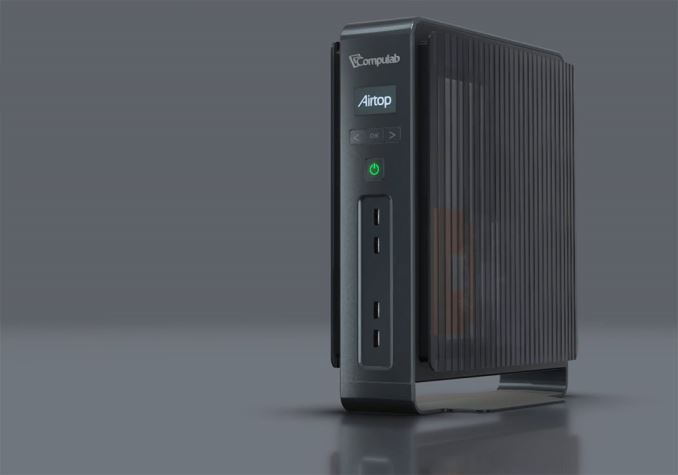
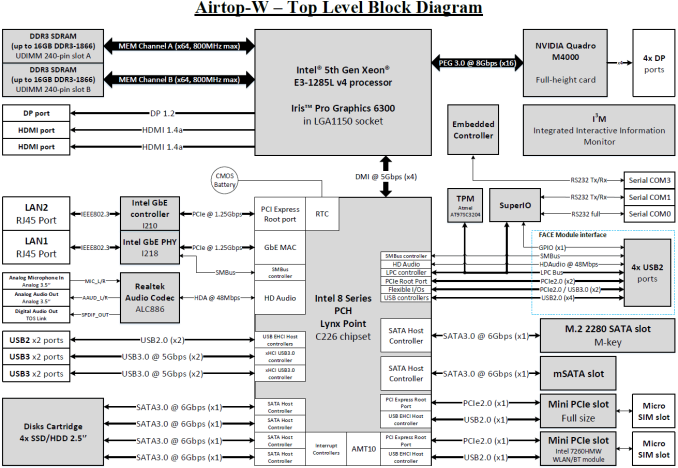
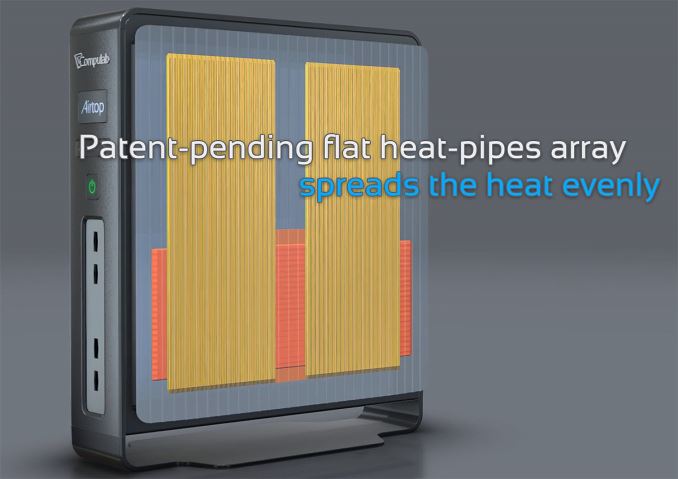
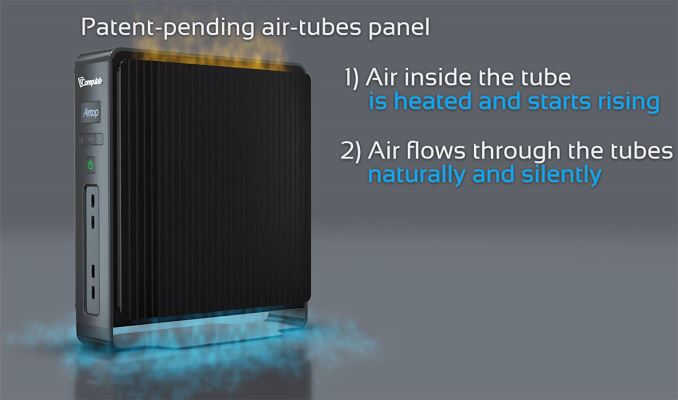
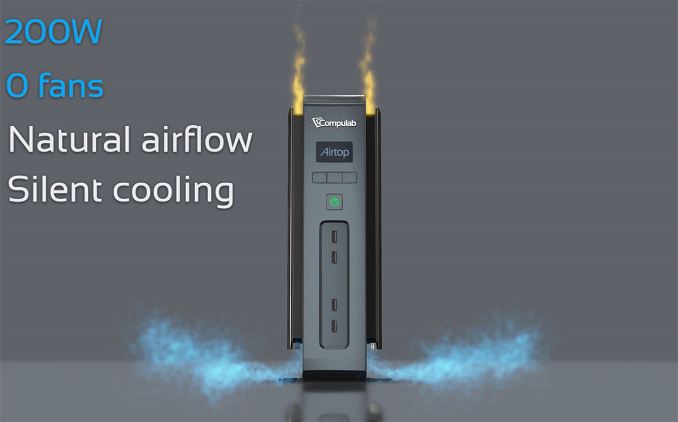








35 Comments
View All Comments
versesuvius - Thursday, January 14, 2016 - link
Take the power supply out (just don't show it in the photos). Take everything else out too, and you have a proprietary system that is very small indeed, that you can patent. One wonders who did not think of it first.Compulab - Thursday, January 14, 2016 - link
- There is nothing new with taking out the power supply (Compulab has been doing it for many years, so does Intel with NUC and countless other). It actually gives the advantage of feeding the computer from a variety of DC sources.- Taking everything else out is a mistake that Apple did with the new Mac Pro. The result is a messy octopus on the desk. Compulab did the opposite with Airtop, it is packed full with internal devices - 4 HDDs, full-height GPU in 80mm wide chassis etc.
- Thinking about miniaturization is one thing. Achieving it in a product is a little more difficult. Better take a closer look at how Airtop is organized internally. You may be pleasantly surprised.
- The patents have nothing to do with minituarization. They are all about thermal design.
ninjaburger - Thursday, January 14, 2016 - link
> Taking everything else out is a mistake that Apple did with the new Mac Pro.And yet it still overheats like no other machine I've ever used.
It's really a brilliant thermal design, if you look at it from the right perspective: while simultaneously maxing out performance on all cores, memory, storage, and GPUs the outer shell stays cool to the touch and the fan is silent!
*Amazing* how they were able to effectively trap all that heat inside to keep it from bothering you while you work...
Alexvrb - Sunday, January 17, 2016 - link
Well, the convection works well enough in their SFF systems. We use them at work. They're not perfect, but they get the job done as long as you give them some breathing space.I can't vouch for their attempts at dissipating a larger amount of heat with this larger box, however. I think above a certain thermal footprint you should just use a silent industrial-grade fan and possibly a filter.
Alexvrb - Sunday, January 17, 2016 - link
Whoops sorry I didn't mean to reply to your comment on the Mac. This was strictly in reference to Compulab convection cooling setups.toronado455 - Friday, January 15, 2016 - link
Speaking of the power supply, can anyone tell me where power goes into this? From the photos I can't figure out where the power supply plugs in.BlueTortoise - Friday, January 15, 2016 - link
It uses the Mini-DIN connectors (that look like old Keyboard/Mouse PS2 ports) on the back for power.I'm not 100% sure why two are required though.
ddriver - Thursday, January 14, 2016 - link
When someone claims to invent convection and the chimney it only makes me laugh.Also, the tubes in that particular case are not only unnecessary, but actually impeding the ability to displace heat, as hot air expands inside the tube this will hamper the airflow.
I am willing to bet regular radiator with vertical fins would do a better job, but hey, then you don't get to make ridiculous claims of innovation.
ddriver - Thursday, January 14, 2016 - link
But given what a pathetic mockery the patent system is, they could totally patent it LOL it will not surprise in the slightest.Compulab - Thursday, January 14, 2016 - link
Please see www.fit-pc.com, this is a Compulab where you will find many versions of finned computers from 5 to 50W. The rule of thumb in convection is stay under 0.1W per cm^2 or you'll burn your hand. Airtop has a wall with an area of approx 500 cm^2 that dissipates 100W and you can touch it.Compulab invented neither convection nor chimneys, but we designed the chimneys in such a way that doubles its cooling capacity. 3 years ago when we started I personally thought its a waste of time, after running Airtop with FurMark in parallel to Prime95 overnight for several months at power consumption of over 150W I admitted it works.
You are entitled to think this is not patentable, our patent attorney tends to disagree.